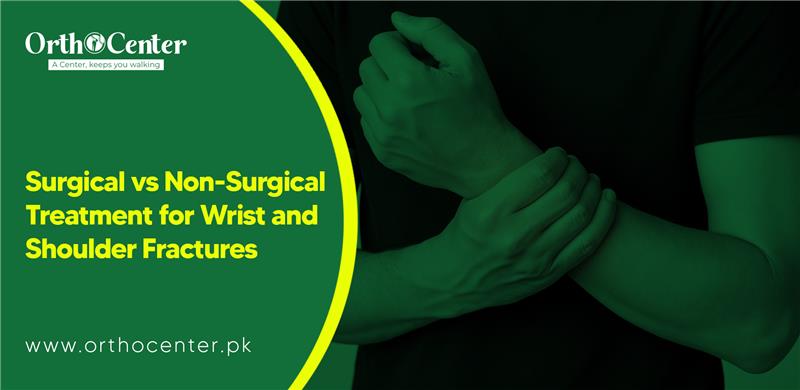Welcome to Our Orthopedic Clinic in Pakistan!

Do you have persistent pain in your shoulder and wrist? Is this due to a temporary injury or an indication of a severe fracture? This is what you need to ask because it depends on the right diagnosis and treatment plan. Deciding between surgical vs non-surgical treatment for wrist and shoulder fractures is crucial for anyone who has experienced a fall, sports injury, or any trauma. Not every treatment is for everyone, but the appropriate treatment approach depends entirely on fracture complexity, location, and lifestyle choices.
On one hand, non-surgical methods are a less invasive path for stable injuries. Conversely, surgical intervention provides the stability needed for the severely fractured bones to heal correctly. This blog offers a clear comparison between surgical vs. non-surgical treatment for wrist and shoulder fractures, giving you adequate knowledge to make an informed decision for your musculoskeletal health.

When you get a wrist or shoulder fracture, the primary aim is to heal the bone properly to achieve normal functioning. But the choice of treatment strictly varies with the nature and severity of the injury. Knowing the differences between surgical vs. non-surgical treatment of wrist and shoulder fractures enables you to make the right choice with your orthopedic doctor.
Doctors generally recommend non-surgical treatment for stable and non-displaced fractures where the bone can heal correctly without any invasive procedure, this conservative path is the preferred choice for the first-line treatment.
If patients have serious injuries and complicated fractures where the bones are fractured, displaced, and involve a joint surface, then a surgical procedure is the appropriate course of action. It is also for serious fractures (broken bones in many pieces) or open fractures where the bone breaks the skin. Surgeons also go for surgical treatment if the bone does not heal properly with the original casting.
After a long period of strict immobilization of bones, Ankle Fracture recovery period starts. Recovery time for non-surgical treatment for wrist and shoulder fractures is 6 to 8 weeks. When patients’ casts are removed, they start rehabilitation to treat joint stiffness, muscle weakness, and atrophy due to extended rest. Physical therapy is required during this time to enable the patients to regain the range of motion, strength, and function of their joints.
As with any operation, surgical treatment for wrist and shoulder fractures also includes some risks. These risks are infection, nerve and blood vessel damage, implant failure, and allergy to anesthesia. Perhaps worst of all, future surgery is needed to remove the metal hardware. Yet surgery is a sound method of obtaining anatomic alignment with complicated fractures.
Personalized Treatment for Wrist & Shoulder Injuries.
| Aspect | Non-Surgical Treatment | Surgical Treatment |
|---|---|---|
| What happens | A cast, splint, or brace holds your fracture in place, providing the stability it needs to heal correctly on its own. | During surgery, your orthopedic surgeon stabilizes the bone fragments with plates, screws, or pins. |
| Recovery time | Typically, 6-8 weeks for the wrist, 8-12 weeks for the shoulder. | Early healing is the same amount of time, but complete recovery could take 3-6 months. |
| Pain level | Moderate pain that improves within days to weeks. | More immediate pain after surgery, but often better long-term pain relief |
| Mobility afterward | May have some stiffness; physical therapy helps regain movement | Generally, better alignment means better function, though rehab is crucial |
| Follow-up care | Regular X-rays to monitor healing, cast changes if needed | Removal of stitches, monitoring hardware, and possible second surgery to remove plates/screws later |
The optimal choice between surgical vs non-surgical treatment for wrist and shoulder fractures is the one your orthopedic surgeon made for you, based on your injuries. This is determined by the patient’s age, activity level, overall health, and severity of the fracture. A stable fracture in a less active individual heals properly with casting, while a complex fracture, even in an active person, requires surgery. The final goal of both treatments is to achieve a successful recovery. Having confidence in your orthopedic surgeon’s skills is the single most significant step you can take to assure you will regain full joint function.
Hence, selecting an appropriate surgeon makes a difference. At Orthocenter, Dr. Ahmed Shoaib, an orthopedic surgeon, offers the treatment of complicated fractures of the wrist and shoulder. He is dedicated to delivering patient-centered care and advising his patients on which treatment route, between surgical vs non-surgical treatment of wrist and shoulder fractures, is suitable for them.
He carefully diagnoses the condition of a patient, and then considers what kind of treatment approach is suitable for this person. His surgical residency, along with the latest rehabilitation and surgical equipment, delivers what you expect: the restoration of joint strength and function with painless movement.
Don’t let any injury keep you behind. Schedule a consultation with Dr. Ahmed Shoaib today to receive a comprehensive evaluation and embark on the path of journey with a surgeon who prioritizes your long-term well-being.
Find the top orthopedic clinic in Pakistan for comprehensive care. Expert treatments for bone, joint & muscle issues. Visit us for trusted solutions.
Ortho Center All Rights Reserved © 2025 Designed, Developed & Marketed by Marketing Agency for Orthopedic Surgeon
WhatsApp Us